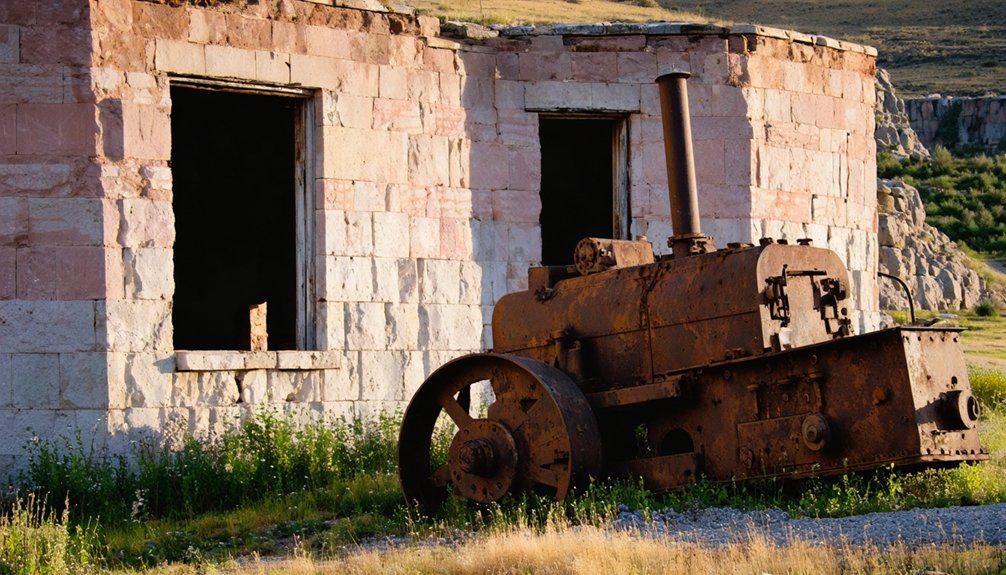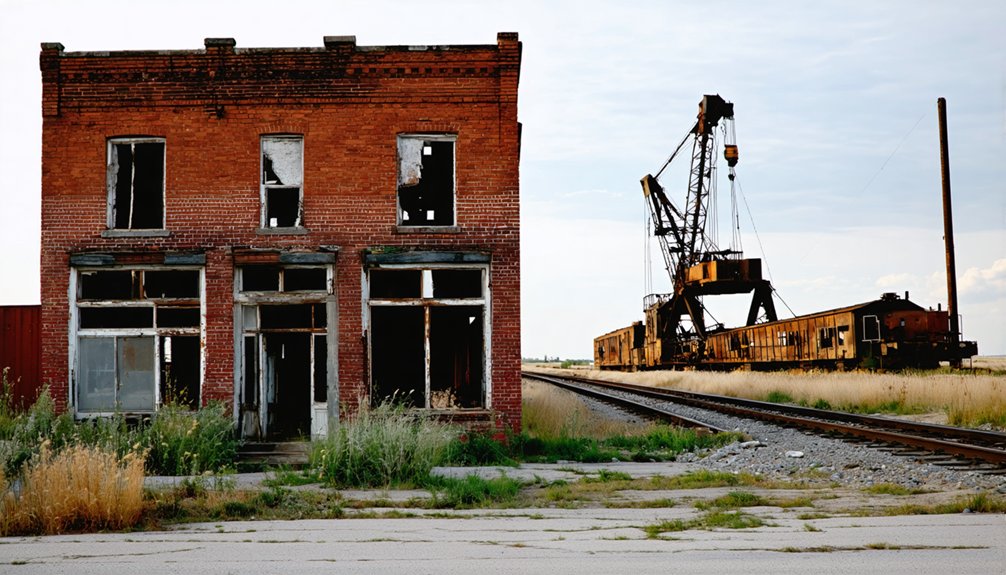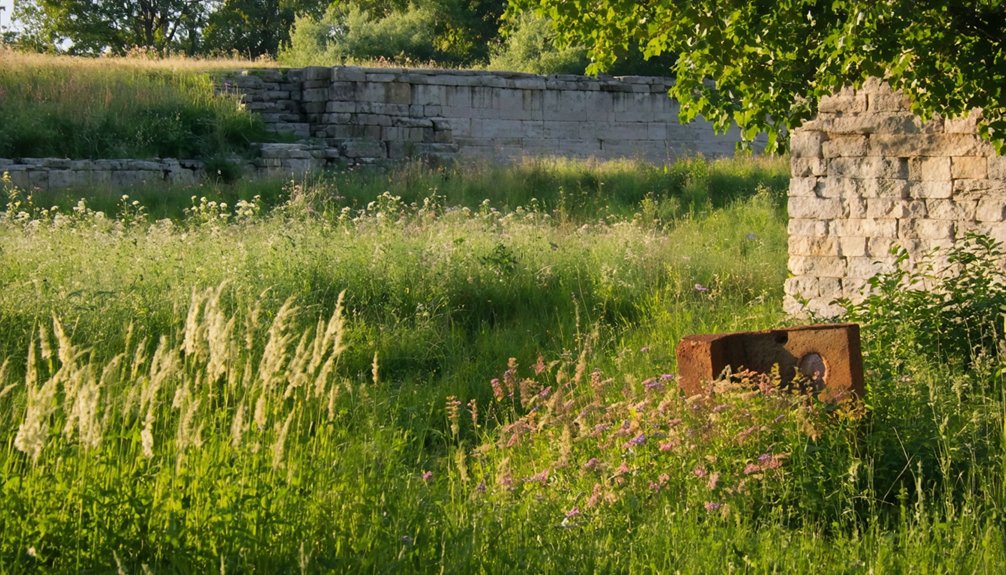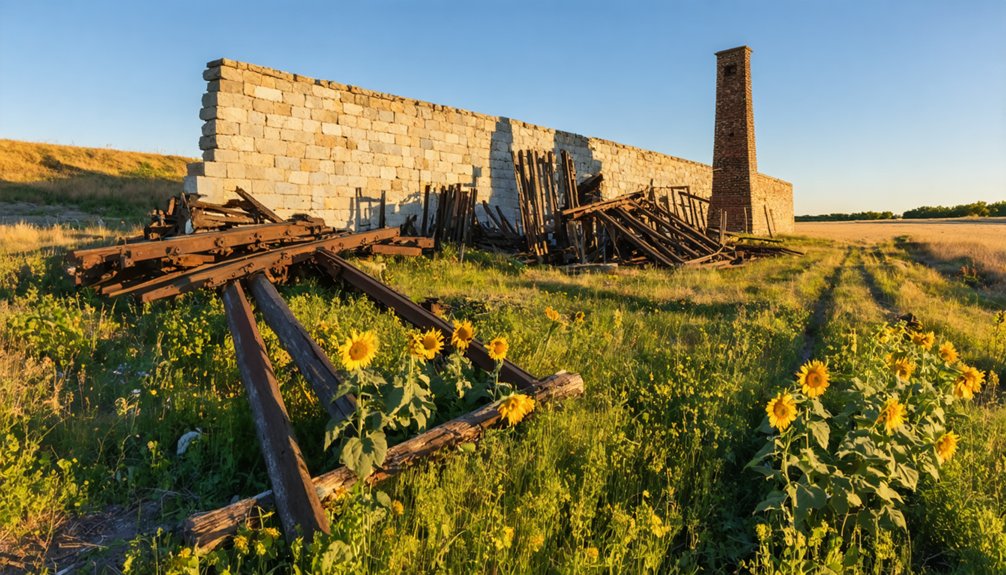You’ll find the remnants of East Sioux Falls along South Dakota’s Big Sioux River, where pink quartzite mining once fueled a bustling frontier town of 600 residents in the 1890s. C.W. Hubbard’s Sioux Falls Granite Company transformed this settlement into a major quarrying hub, shipping 62 million stone blocks nationwide via the Illinois Central Railroad. While the town declined as construction trends changed, its scattered foundations and the Perry Nature Area preserve its rich mining heritage.
Key Takeaways
- East Sioux Falls was established in the 1880s as a quartzite mining town, reaching a peak population of over 600 residents.
- The town flourished through quartzite stone production, shipping 62 million blocks to major cities via the Illinois Central Railroad.
- European immigrants, particularly skilled stonecutters from Scandinavia and Britain, formed the core of the town’s workforce.
- Economic decline occurred when construction trends changed, leading to the town’s eventual abandonment and ghost town status.
- Today, brick foundations and remnants remain preserved at the Mary Jo Wegner Arboretum and Perry Nature Area.
The Birth of a Mining Frontier Town
While many frontier towns emerged from the discovery of precious metals, East Sioux Falls grew from the pink quartzite beds along the Big Sioux River in South Dakota.
In the late 1880s, C.W. Hubbard’s Sioux Falls Granite Company established quarry operations six miles east of Sioux Falls, transforming the site from a simple settlement called Ives into a bustling mining community. The company shipped an impressive 62 million blocks of quartzite stone to major cities across the country.
You’d have found a strategic blend of natural resources and transportation, as the Illinois Central Railroad extended its tracks to serve the quarries. The railroads transported stone to major Midwestern cities like Detroit, St. Louis, and Chicago.
By 1890, over 600 residents, many of them skilled European stonecutters, called East Sioux Falls home.
Despite harsh labor conditions that included exposure to deadly stone dust, workers flocked to the town’s promise of steady employment and the vibrant community life that followed.
Quartzite: The Pink Gold of East Sioux Falls
The majestic pink quartzite that built East Sioux Falls stands as one of nature’s most remarkable building materials.
You’ll find this incredibly hard stone, nearly diamond-tough, gets its distinctive pink to maroon hue from iron oxide, earning its “Pink Gold” nickname. The quartzite properties made it perfect for construction – you couldn’t ask for a more durable building stone. Skilled stonecutters from Scandinavia and Britain shaped the quartzite by hand during the peak quarrying years.
Hard as diamond and colored by iron, this pink quartzite’s legendary durability made it the ultimate construction stone.
Under George H. Perry’s East Sioux Falls Quarry Company, crews extracted massive blocks of this prized rock, shipping it across America for prestigious buildings and street paving. Modern operations like Concrete Materials now produce 1 million tons annually of quartzite for construction needs.
The quartzite’s superior strength and beauty made it the preferred choice for landmarks like Sioux Falls’ Old Courthouse Museum.
Today, you’ll still find modern quarrying operations mining this ancient stone, though now it’s primarily crushed for aggregate rather than cut into building blocks.
Railway Dreams and Economic Growth
You’ll find that East Sioux Falls’ explosive growth began when the Illinois Central Railroad completed its line in 1887, transforming a quiet settlement into a bustling hub of over 600 residents by 1890.
The fourth major railroad to reach the area made East Sioux Falls an important stop on the route connecting Sioux Falls to Chicago via Cherokee, Iowa.
The strategically placed depot became the heart of commerce, spurring rapid development of worker cottages, civic buildings, and diverse businesses to serve the expanding population. Similar to the Great Northern rail line that operated nearby, these railways played a crucial role in regional development.
The rail connection revolutionized the town’s economy by enabling efficient shipment of quartzite stone to major markets like Chicago while facilitating the arrival of essential goods and materials that sustained the community’s growth.
Railroad Sparks Town Growth
During the late nineteenth century, railroads revolutionized East Sioux Falls by transforming it from a modest settlement into a bustling industrial hub. You’ll find the railroad history of this region deeply intertwined with the Illinois Central Railroad’s arrival in 1888, which sparked an unprecedented economic shift. The construction of a vital railroad depot that year cemented the town’s position as a major transportation center.
The Great Dakota Boom brought rapid changes as you’d witness multiple railroad lines connecting East Sioux Falls to Chicago and beyond. This network didn’t just move quartzite from local quarries – it sparked the development of hotels, stores, and a post office. The town’s success was largely due to quarry partners Hubbard and Riley expanding their operations in 1887.
Depot Hub Drives Commerce
When Illinois Central Railroad established its depot in East Sioux Falls in 1888, a vibrant commercial hub emerged practically overnight.
You’d have witnessed an economic ripple as businesses sprouted around the station – hotels, saloons, and general stores serving railroad workers and freight operations.
The depot’s significance extended beyond just moving stone from local quarries; it transformed the town into a vital transportation nexus.
Freight Lines Enable Expansion
As Illinois Central Railroad extended its tracks westward from Iowa in 1888, East Sioux Falls underwent a dramatic transformation into a major freight hub for the region’s quartzite industry.
You’ll find that the freight logistics revolutionized the quarry business, enabling mass transport of the area’s distinctive pink jasper stone to metropolitan markets like Chicago.
The transportation innovation couldn’t have come at a better time. You’d no longer need to rely on weather-dependent wagons or limited river transport – instead, standardized rail shipping made it possible to move larger volumes of stone with predictable schedules and lower costs.
This railway connection helped the town’s population surge to over 600 residents by 1890, as the improved freight capacity attracted workers and spurred development of auxiliary businesses, from grain elevators to general stores.
Life in a Bustling Boomtown

You’d find East Sioux Falls’ quarrymen hard at work from dawn to dusk, skillfully cutting and shaping the prized Sioux quartzite into building blocks and paving stones.
After their grueling shifts ended, workers would flock to the town’s saloons and boarding houses, where drinking and fighting became common pastimes in this “wide-open” community.
The town attracted skilled immigrant stonecutters who brought their expertise all the way from Wales, England, and Scotland to work in the demanding quarry industry.
The contrast between the disciplined daytime labor and rowdy nightlife created a distinct social rhythm typical of late 19th-century boomtowns, where both English and Welsh stonecutters found entertainment alongside Scottish immigrants.
The town’s lively atmosphere peaked during the July 4, 1892 celebration that drew an impressive crowd of 3,500 people to the bustling quarry town.
Quarrymen’s Daily Routines
Three distinct groups of workers formed the backbone of East Sioux Falls’ quarrying operations in the late 1800s: the stonecutters who shaped the quartzite blocks, the laborers who transported the stone via tram cars, and the skilled artisans who created finished products.
If you’d visited during its peak, you’d have witnessed a tight-knit community of European immigrants, primarily from Wales, England, and Scotland, practicing their craft.
The quarrymen’s camaraderie was evident in their daily rituals, from the early morning trek to the quarries along the Big Sioux River bluffs to the shared struggles against hazardous working conditions.
You’d have seen them battling “stonecutter’s consumption” from inhaling stone dust while operating Perry’s newly introduced stone-crusher and working the cutting areas, transforming pink quartzite into valuable building materials. After long days of labor, many workers found relief at the town’s post office and saloon, where they gathered to unwind and socialize.
Social Life After Dark
When the quarrymen’s shifts ended and darkness settled over East Sioux Falls, the town of 600 transformed into a vibrant social hub where workers sought entertainment and relaxation.
You’d find the heart of nighttime gatherings centered around the town’s saloons, where Welsh, English, and Scottish stonecutters would unwind after long days at the quarry.
The town’s saloon culture offered more freedom than neighboring communities, with activities including:
- Spirited drinking and socializing among diverse immigrant groups
- Casual fighting and boisterous carousing
- Impromptu gatherings that often spilled into the streets
The town hall hosted regular community events, while boarding houses buzzed with activity as workers shared stories and planned weekend cricket matches.
This after-hours social scene helped forge bonds among the immigrant workers who’d journeyed far from their homelands.
The Welsh and Scottish Stone Masters
As the quartzite industry flourished in East Sioux Falls during the late 1880s, skilled stonecutters from Wales and Scotland arrived with their families, bringing generations of masonry expertise to the Dakota Territory.
The Welsh heritage and Scottish influence quickly shaped the town’s character, as these master craftsmen applied their specialized skills to cutting and shaping the region’s hard sedimentary stone.
Celtic craftsmanship reshaped the frontier, as skilled stoneworkers brought generations of masonry expertise to tame the rugged Dakota quartzite.
You’ll find their legacy in the high-quality paving stones and building blocks they produced, which were shipped to major cities like Detroit, Chicago, and St. Louis.
Using traditional hand tools like hammers and chisels, they transformed raw quartzite into architectural elements that still stand today.
Their craftsmanship wasn’t just about manual labor – it was an art form passed down through generations, demanding precision and skill.
From Prosperity to Economic Collapse

The story of East Sioux Falls’ economic rise and fall hinges on the fateful years between 1888 and 1900. You’ll find a remarkable quartzite history where a small settlement transformed into a thriving town of 577 residents, driven by the mining culture that defined its identity.
The Illinois Central Railroad’s arrival in 1888 connected the town’s stone quarries to major markets, sparking unprecedented growth.
- The town’s infrastructure expanded rapidly, featuring 33 cottages, boarding houses, and essential services to support the mining workforce.
- At its peak, 300 of the 400 residents worked as pavers and cutters in four bustling quarries.
- By the early 1900s, changing construction trends and cheaper materials led to the town’s dramatic decline, forcing families to abandon their homes.
Traces of the Past: What Remains Today
Modern visitors to East Sioux Falls will find only scattered brick foundations and architectural remnants where a bustling quarry town once stood. The site’s historical preservation now centers on the Mabel and Judy Jasper Education Center, which houses archives and artifacts documenting the town’s rise and fall.
You’ll discover the 145-acre Mary Jo Wegner Arboretum has transformed the once-deteriorated “dump” into a natural sanctuary, where brick ruins blend with cultivated gardens and wild flora. This ecological integration showcases nature’s reclamation of human industry.
A 1994 historical marker near Highway 11 guides you to the location, though minimal structural remains limit exploration. The Minnehaha Historical Society maintains the site’s legacy through educational programs rather than commercial development, ensuring the ghost town’s story endures through a conservation-focused approach.
The Perry Nature Area Legacy

Following decades of private ownership, prominent businessman George H. Perry and his family maintained the East Sioux Falls town site for over 100 years before donating 23 acres to Minnehaha County in 1999.
This generous gift established the Perry legacy of nature preservation, transforming the historic property into today’s Perry Nature Area.
The Perry Nature Area’s significance extends beyond its historical value through:
- Integration with Mary Jo Wegner Arboretum, creating a premier recreational destination
- Protection of native wildlife, including the state’s second-oldest Burr Oak tree
- Preservation of cultural artifacts, mining ruins, and spring perennials planted by early residents
You’ll find carefully restored trails, interpretive signage, and educational facilities that honor both the site’s industrial past and its natural beauty, ensuring the Perry legacy lives on through public engagement and environmental stewardship.
South Dakota’s Lost Mining Communities
While East Sioux Falls represents one chapter in South Dakota’s mining history, dozens of similar communities dot the state’s landscape as remnants of a bygone era. You’ll find these lost mining communities scattered throughout the Black Hills, where the 1874 gold rush sparked a flurry of settlement and innovation in mining technology.
Towns like Rockerville, Spokane, and Hornblend emerged as bustling camps before falling silent as the mines dried up.
Today, you can explore these ghost towns in various states of preservation. Some, like Rochford, have reinvented themselves as tourist destinations, while others remain as barren sites with only foundations marking their existence.
Ghost town preservation efforts focus on protecting these historical treasures, allowing you to walk through the remnants of stamp mills and peer into abandoned mine shafts that once drove the state’s economy.
Frequently Asked Questions
Were There Any Notable Crimes or Murders in East Sioux Falls?
You won’t find any infamous incidents or documented crimes in the historical record. While local legends exist in nearby areas, there’s no evidence of notable murders in this mining town.
What Happened to the Machinery and Equipment When the Quarries Closed?
Mountains of quarry equipment were sold at auction, relocated to other sites, or scrapped for salvage. You’ll find they recycled machinery through Sioux Falls facilities while properly disposing of hazardous materials.
Did Any Original Buildings From East Sioux Falls Survive Elsewhere?
You won’t find any original buildings preserved elsewhere – despite their architectural significance, no structures from East Sioux Falls were saved through historic preservation efforts. They were all demolished or lost by mid-20th century.
What Was the Average Wage of Quarry Workers in East Sioux Falls?
You can’t find exact wage history for East Sioux Falls quarry labor, but similar workers in South Dakota typically earned around what would be $50,324 annually in today’s equivalent value.
Were There Any Known Native American Settlements Before East Sioux Falls?
You’ll find that Dakota tribes used the area for seasonal activities, though there’s no evidence of permanent settlements at the exact site. The region held historical significance in Native trading and hunting patterns.
References
- https://www.argusleader.com/story/news/2019/06/27/how-quartzite-created-and-crumpled-ghost-town-east-sioux-falls/1527708001/
- https://www.southdakotamagazine.com/south-dakota-ghost-towns
- https://www.sdpb.org/rural-life-and-history/2023-08-21/some-black-hills-ghost-towns-and-their-origins
- https://en.wikipedia.org/wiki/East_Sioux_Falls
- https://973kkrc.com/the-fascinating-story-of-the-lost-city-of-east-sioux-falls/
- https://en.wikipedia.org/wiki/List_of_ghost_towns_in_South_Dakota
- https://www.argusleader.com/picture-gallery/news/2019/06/26/photos-ghost-town-east-sioux-falls-once-bustling-mining-town/1549537001/
- https://b1027.com/south-dakota-has-an-abundance-of-ghost-towns/
- https://history.sd.gov/museum/docs/Mining.pdf
- https://www.localloupodcast.com/episodes-of-local-lou/the-city-of-east-sioux-falls



